
Correspondence held in the Australian National Archives from Mary and O’Dell’s father John, who was the proprietor of the Bingara Cordial Factory, reveal their desperate attempts to discover what had happened to him, including Mary pleading to know if he had uttered any last words. Heartbroken, she died three years later.
And yet, apart from their graves hewn from the parched, rocky Maltese earth, there is little other physical evidence the Anzacs were ever in Malta, despite the enormity of their presence over a century ago.
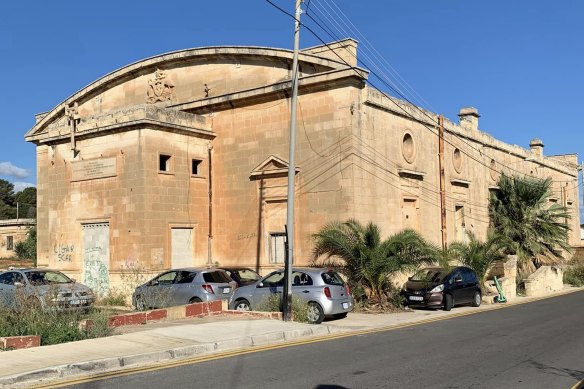
Still standing despite relentless air raids in WWII, a fire in 1998 and ambitious property developers, Australia Hall in Malta.
Tucked away a few blocks behind the bustling cafes and bars of the picturesque holiday spot St Julians Bay stands one unmissable remnant: a crumbling Australian coat of arms adorning a stone ruin known as Australia Hall.
Miraculously, having survived WWII air raids, fire in 1998 and seen off plans to build a supermarket and a new Chinese embassy on the site, the building is intact, surrounded by fields of prickly pear, avenues of heavily scented pink oleanders, nondescript apartment buildings and neighbouring St Catherine’s High School.
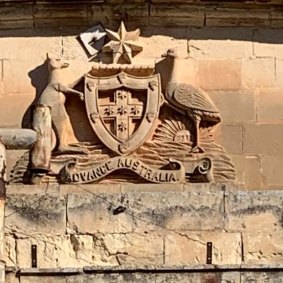
The Australian coat of arms atop Australia Hall in Malta.
But in 1915 Australia Hall was a vastly different place, a beacon of mateship for convalescing Anzacs far from home.
Some 2000 of them could be accommodated within its stately hall at any given time, playing cards, writing letters to worried family, singing by the piano and sipping cups of tea, or something stronger when the ghosts of the battlefield came to haunt them.
The fortresslike structure was hurriedly built by the royal engineers in just two months, with £2000 raised by the Australian Red Cross – around $250,000 in today’s money.
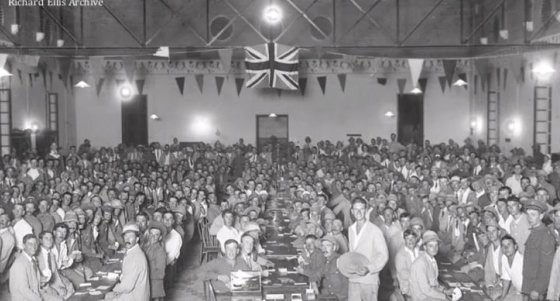
A gathering of convalescing Anzacs in Australia Hall during 1915.Credit: Richard Ellis Archive
Malta, home to the crusading Knights of St John in the 16th century, was dubbed “the nurse of the Mediterranean” during the disastrous Gallipoli campaign.
“It is an extraordinary and proud history we Maltese share with Australia and the Anzacs, but it is one I don’t think is widely known across Australia … even though it truly deserves to be,” Maltese historian John Portelli told the Herald from Valletta.
The voyage across the Eastern Mediterranean in these makeshift hospital ships from the Gallipoli Peninsula to Malta was not an easy one.
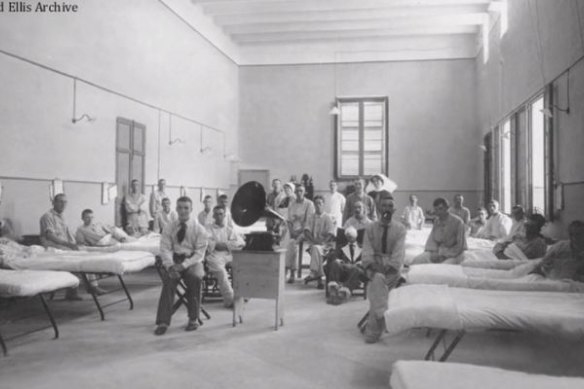
Australian troops and nurses in Malta during Gallipoli campaign.Credit: Richard Ellis Archive
It took the steam ships up to eight days to cover the 1163-kilometre journey, and newspaper clippings paint a horrific image of their arrival in Valletta’s fortified Grand Harbour; unloading human cargo of wounded, many septic and barely alive young men, their motionless bodies delicately lowered on stretchers by ship cranes onto barges waiting alongside.
At the beginning of April 1915, there were 824 military hospital beds in Malta. At the end of May 1915, there were more than 6000 in 14 hospitals spread all over the island. At its peak there were 25,522 beds in 28 hospitals, with the highest number of patients on any one day a staggering 16,004.
Loading
The Daily Malta Chronicle reported an unnamed Australian infantryman “found a bullet had struck the bible in his (breast) pocket. The bullet penetrated as far as the gospel of St Matthew … resting on the words ‘Till I put thine enemies underneath thy feet’.”
Initially, the wounded were given a hero’s welcome, cheered by locals who tossed sweets, cigarettes and flowers into the passing horse-drawn ambulances. But as the numbers grew, the arrivals became more subdued. Even the church bells, of which there are hundreds across the staunchly Roman Catholic islands, fell silent.
Prominent Maltese politician and lawyer Herbert Ganado wrote in his memoir of what he witnessed at Porta Reale as the soldiers were brought ashore: “Masses of people packed the Strada Reale … Large crowds lined both sides and waited silently … Some clapped but were quickly shushed by the crowd. It was not an occasion for noise and shouting.”
“The people, particularly mothers in the crowds, became very emotional … Some of the wounded waved, smiled and looked happy they had been welcomed with such love and spontaneous attention.”
Only a day after the first wounded arrived, Ganado writes of witnessing the first of many military funerals.
“This is how I learned Chopin’s Funeral March, and now, whenever I hear the music, this scene comes to mind: a firing party, rifles at reverse arms, pointing downwards, a band and a coffin draped in the Union Jack on a gun carriage. Occasionally, one saw six or seven coffins in the same funeral procession.”
The Maltese compassion and hospitality did not go unnoticed back in Australia.
Inside St Andrews Scots Church in Valletta are two stained-glass windows representing Christ the Light and Christ the Good Shepherd, commissioned by the Vasey family from the Melbourne suburb of Malvern.
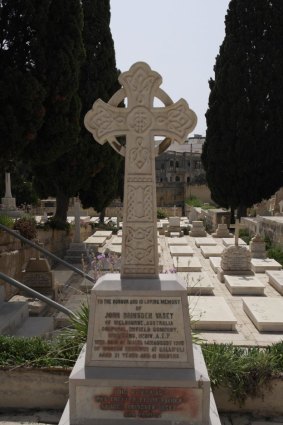
Australian soldier John Vasey’s grave at Pieta Cemetery in Malta.
On August 14, 1915, corporal John Vasey of the Second Field Company died of septicemia, a month shy of his 21st birthday, having lost a leg after being wounded at Gallipoli. Vasey is buried at Pieta. According to war records his family received a collection of “personal effects” which included a shaving brush, notepad, fountain pen, matchbox and a pair of mittens.
Vasey’s brother George would later join the front and during WWII became one of Australia’s most storied warriors. Major General George Vasey’s wife Jessie founded the War Widows Guild.
In 1921 the Vasey brothers’ father, also named George, presented the stained-glass windows on behalf of the broader Australian Methodist community as a gift to the Maltese in honour of his son John and other Anzacs buried there.
Today Vasey family descendants are as largely unaware of the windows’ provenance as the dwindling congregation at St Andrews, however a small plaque on the wall mentions the Australian connection.
Loading
Such warm relations were not displayed less than a decade later in Queensland’s cane fields, where Maltese immigrants were grouped by The Truth newspaper with other “mixed races of indefinite breed” allegedly “sweep[ing] into our open ports, sans character, morals, principles, health, and frequently, cash”, and “ignorant of all sanitary precautions … animal-like in their tastes; brutal in their relationships … grossly superstitious and illiterate.”
The misguided prejudice wasn’t to last, especially with the indignant Maltese making it clear they were just as much a part of the British Empire as Australia. By 1948 the Australia-Malta Assisted Passage Agreement officially recognised the Maltese as “preferred” migrants. Over the next half-century, tens of thousands would come to Australia.
According to the 2021 census, Australia is home to 234,402 people either born in Malta or claiming Maltese ancestry, about half the current population of Malta itself.
Start the day with a summary of the day’s most important and interesting stories, analysis and insights. Sign up for our Morning Edition newsletter.



























